child seat Oldsmobile Cutlass Supreme 1996 Owner's Manuals
[x] Cancel search | Manufacturer: OLDSMOBILE, Model Year: 1996, Model line: Cutlass Supreme, Model: Oldsmobile Cutlass Supreme 1996Pages: 356, PDF Size: 18.48 MB
Page 19 of 356
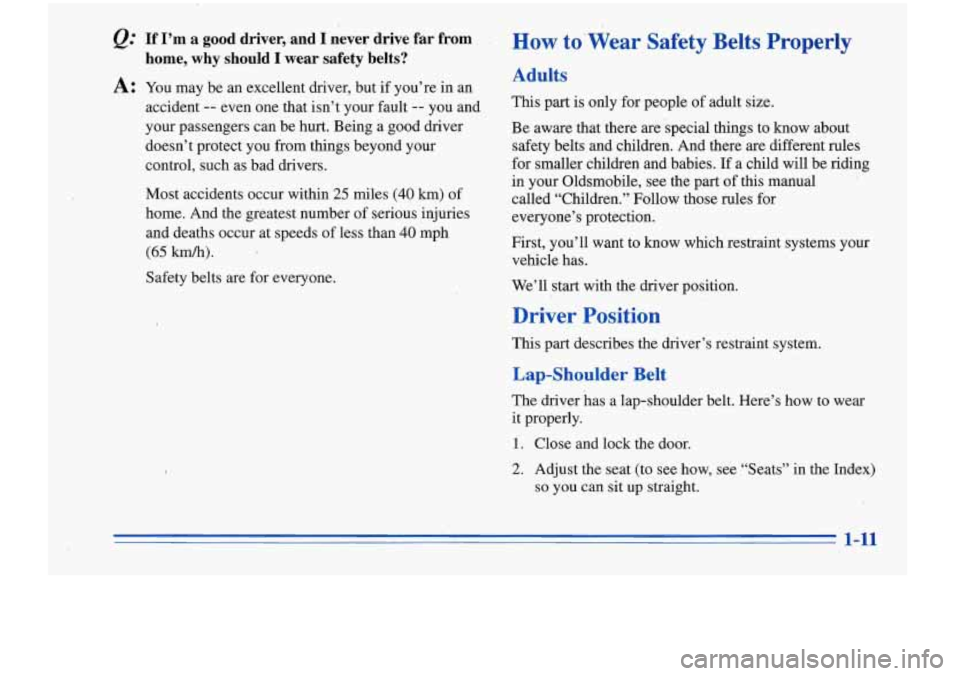
If I’m a good driver, and I never drive far from
home, why should I wear safety belts?
A: You may be an excellent driver, but if you’re in an
accident
-- even one that isn’t your fault -- you and
your passengers can be hurt. Being a good driver
doesn’t protect you from things beyond your
control, such as bad drivers.
Most accidents occur within
25 miles (40 km) of
home. And the greatest number of serious injuries
and deaths occur at speeds of less than
40 mph
(65 km/h).
How to‘ Wear Safety Belts Properly
Adults
This part is only for people of adult size.
Be aware that there are’special things to know about
safety belts and children. And there are different rules
for smaller children and babies.
If a child will be riding
in your Oldsmobile, see the part of this manual
called “Children.” Follow those rules for
everyone’s protection.
First, you’ll want to know which restraint systems your
vehicle has.
We’ll start with the driver position.
Safety
belts are for everyone.
Driver Position
This part describes the driver’s restraint system.
Lap-Shoulder Belt
The driver has a lap-shoulder belt. Here’s how to wear
it properly.
i. Close and lock the door.
2. Adjust the seat (to see how, see “Seats”
in the Index)
so you can sit up straight.
1-11
Page 42 of 356

Rear Safety Belt Comfort Guides
for Children and Small Adults
(&Door Models)
Four-door models may have rear shoulder belt comfort
guides. This feature will provide added safety belt
comfort for children who have outgrown child restraints
and for small adults. When installed on a shoulder belt,
the comfort guide pulls
the belt away from the neck
and head.
There is one guide for each outside passenger position in
the rear seat.
To provide added safety belt comfort for
children who have outgrown child restraints and for
smaller adults, the comfort guides may be installed on
the shoulder belts. Here's how to 'install a comfort guide
and use the safety belt:
1. Pull the elastic cord out from between the edge of
the'seatback and the interior body to remove the
guide from its storage clip.
1-34
Page 44 of 356

II
4. Buckle, position and release the safety belt as
described
in “Rear Seat Outside Passenger Positions
’ (4-Door Models)” earlier in this section. Make sure
that the shoulder belt crosses the shoulder.
To remove and store the comfort guides, just perform
these steps in reverse order. Squeeze the belt edges
together
so that you can take them out from the guides.
Pull the guide upward to expose its storage clip, and
then slide the guide onto the clip. Rotate the guide and
clip inward and in between the seatback and the interior
body, leaving only the loop
of elastic cord exposed.
Children
Everyone in a vehicle needs protection! That includes
infants and
all children smaller than adult size. In fact,
the law in every state in the United States and in every Canadian province says children up to some age must be.
restrained while in a vehicle.
Smaller Children and Babies
Smaller children and babies should always be
restrained in
a child or infant restraint. The
instructions for the restraint will say whether it
is the right type and size for your child.
A very
young child’s hip bones are
so small that a
regular belt might not stay low on the hips, as it
should. Instead, the belt will likely be over the
child’s abdomen. In
a crash, the belt would apply
force right on the child’s abdomen, which could
cause serious or fatal injuries.
So, be sure that
any child small enough for one is always properly
restrained in
a child or infant restraint.
1-36
Page 46 of 356
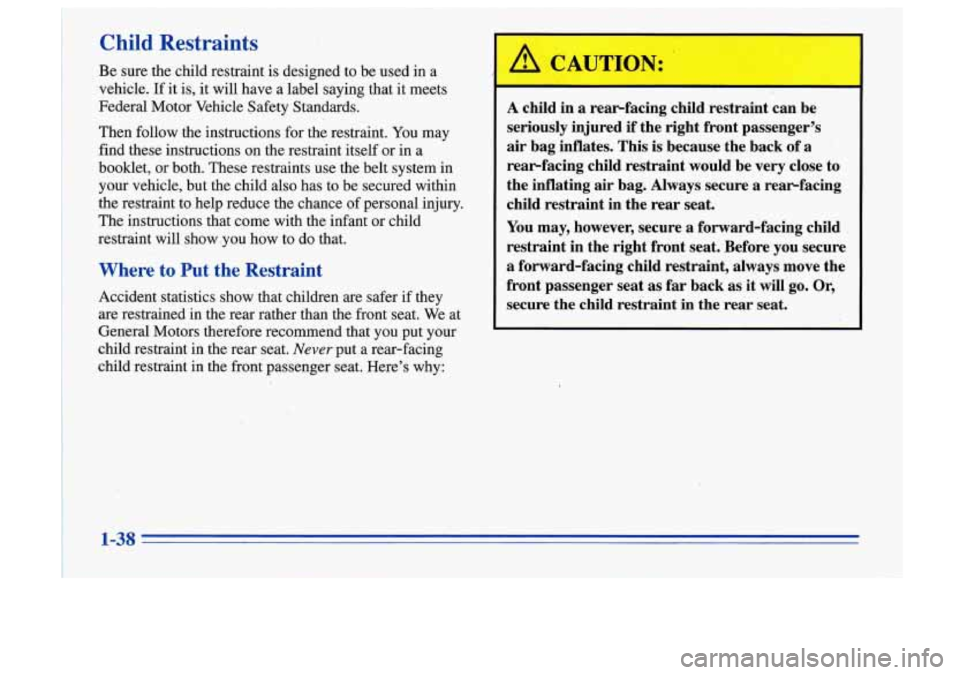
Child Restraints
Be sure the child restraint is designed to be used in a
vehicle.
If it is, it will have a label saying that it meets
Federal Motor Vehicle Safety Standards.
Then follow the instructions for the restraint. You may
find these instructions on the restraint itself or in a
booklet, or both. These restraints use the belt system in
your vehicle, but the child also has to be secured within
the restraint to help reduce the chance of personal injury.
The instructions that come with the infant or child
restraint will show,you how to do that.
Where to Put the Restraint
Accident statistics show that children are safer if they
are restrained in the rear rather than the front seat. We at
General Motors therefore recommend that
you put your
child restraint in the rear seat.
Never put a rear-facing
child restraint in the front passenger seat. Here's why:
A CAUTlJN:
A child in a rearfacing child restraint can be
seriously injured
if the right front passenger's
air bag inflates. This is because the back of a
rearfacing child restraint would be very close to
the inflating air bag. Always secure a rearfacing
child restraint in the rear seat.
You may, however, secure
a forward-facing child
restraint in the right front seat. Before you secure
a forward-facing child restraint, always move the
front passenger seat as
far back as it will go. Or,
secure the child restraint in the rear seat.
!
1-38
.., . ,. -.- ,I . . ... '.,. . -. " .. , . .. .-
Page 48 of 356
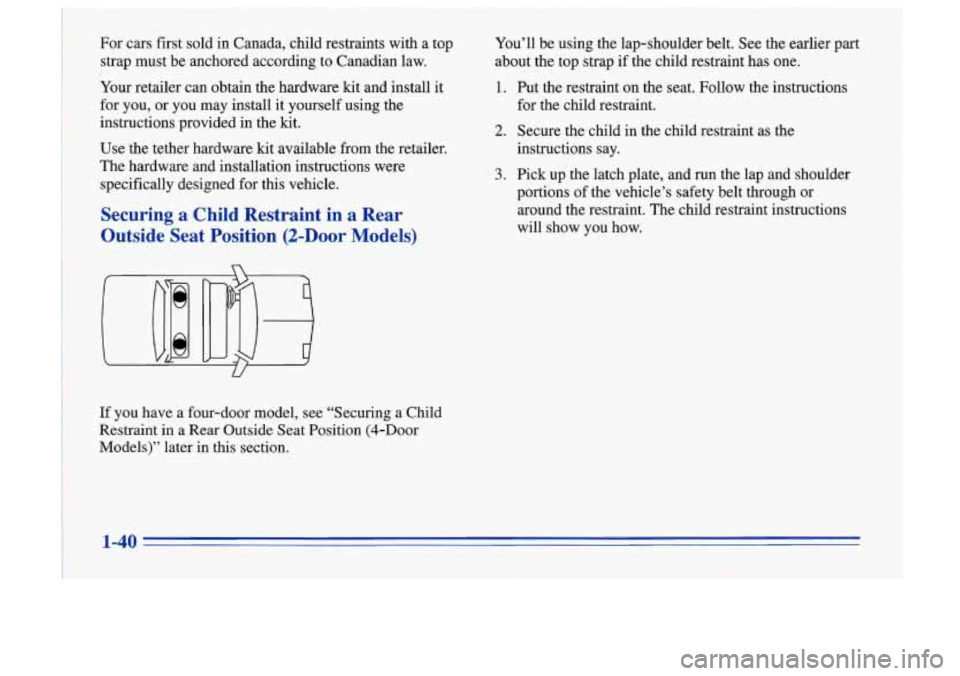
I For cars first sold in Canada, child restraints with a top
strap must be anchored according to Canadian law.
I
Your retailer can obtain the hardware kit and install it
for you, or you may install it yourself using the
instructions provided in the kit.
Use the tether hardware kit available from the retailer.
The hardware and installation instructions were
specifically designed for this vehicle.
~ Securing a Child Restraint in a Rear
Outside Seat Position (2-Door
Models)
U
If you have a four-door model, see “Securing a Child
Restraint in a Rear Outside Seat Position @-Door
Models)” later in this section.
I
You’ll be using the lap-shoulder belt. See the earlier part
about the top strap if the child restraint has one.
1. Put the restraint on the seat. Follow the instructions
for the child restraint.
2. Secure the child in the child restraint as the
instructions say.
3. Pick up the latch plate, and run the lap and *shoulder
portions of the vehicle’s safety belt through or
around the restraint. The child restraint instructions
will show you how.
Page 50 of 356

5. To tighten the belt, pull up on the shoulder belt while
6. Push and pull the child restraint in different
To remove the child restraint, just unbuckle the vehicle’s
safety belt and let
it go back all the way. The safety ,belt
will move freely again and be ready to work for an adult
or larger child passenger. you push down on the child restraint.
directions to be sure it is secure.
Securing a Child Restraint in a Rear
Outside Seat Position (4-DOor Moilels)
If you have a two-door model, ,see “Securing a Child
Restraint in
a Rear Outside Seat Position (2-Door
Models)” earlier in this section:
You’ll be using the lap-shoulder belt. See the
earlier part
about the top strap if the child restraint has one.
1. Put the restraint on the seat. Follow the instructions
for the child restraint.
2. Secure the child in the child restraint as the
instructions say.
3. Pick up the latch plate, and run the lap and shoulder
portions of the vehicle’s safety belt through or
around the restraint. The child restraint instructions
will show you how.
If the shoulder belt goes in front of the child’s face or
neck, put it behind the child restraint.
Page 52 of 356
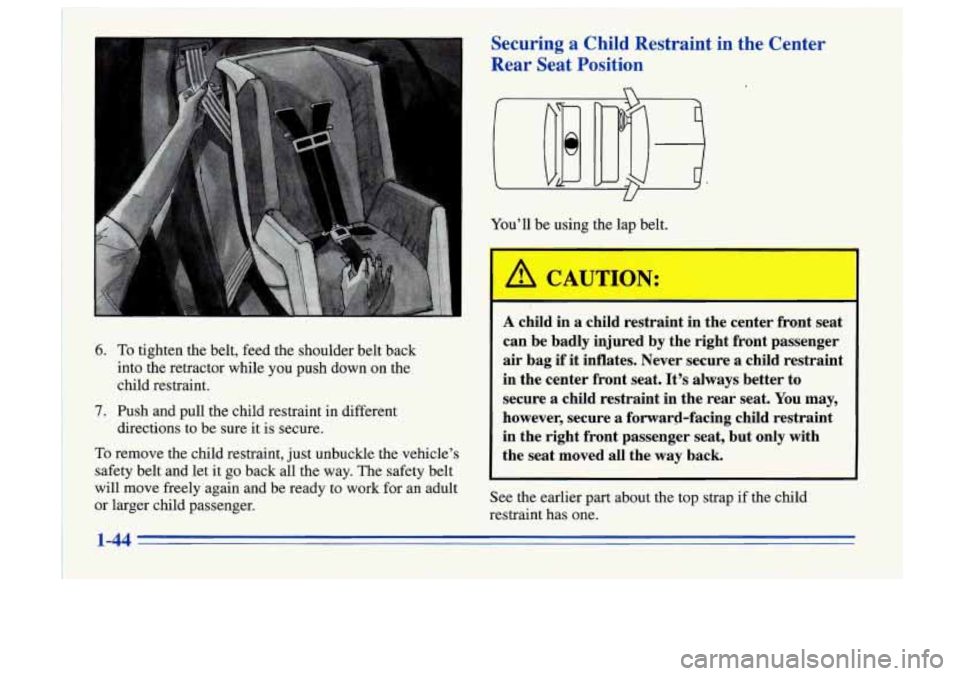
6. To tighten the belt, feed the shoulder belt back
into the retractor while you push down on the
child restraint.
7. Push and pull the child restraint in different directions to be sure it is secure.
To remove the child restraint, just unbuckle the .vehicle’s
safety belt and let it go back all the way. The safety belt
will move freely again and be ready to work for an adult
or larger child passenger.
Securing a Child Restraint in the Center
Rear Seat Position
You’ll be using the lap belt.
A CAFTTTn
A child in a child restraint in ‘the center front seat
can be badly injured by the right front passenger
air bag if it inflates. Never secure a child restraint
in the center front seat. It’s always better to
secure
a child restraint in the rear seat. You may,
however, secure
a forward-facing child restraint
in the right front passenger seat, but only with
the seat moved all the way back.
See the earlier part about the top strap if the child
restraint has one.
1-44
Page 54 of 356
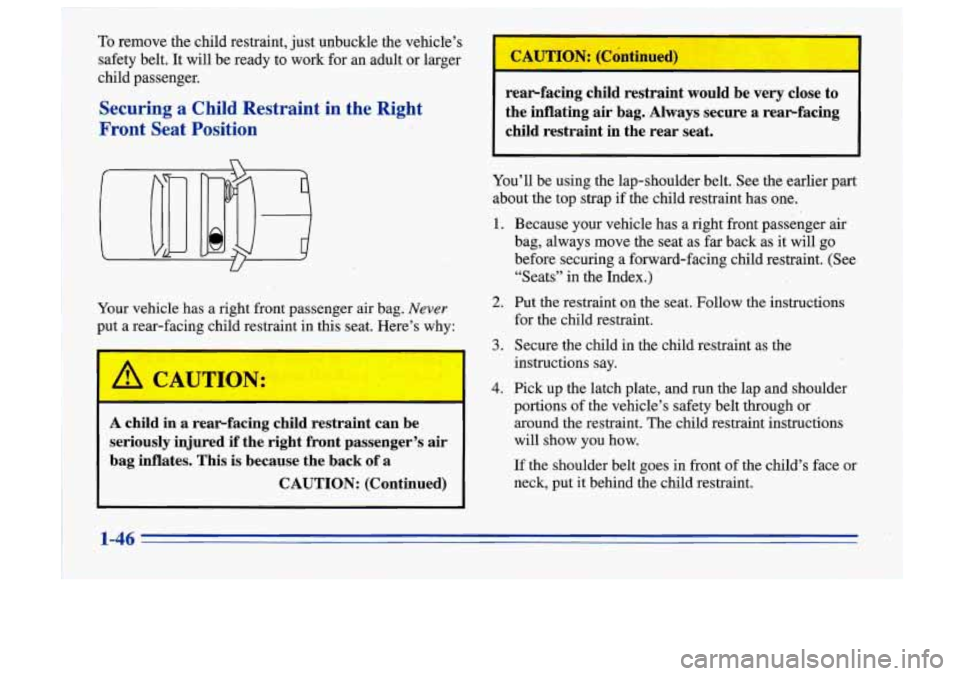
1
To remove the child restraint, just unbuckle the vehicle’s
safety belt. It
will be ready to work for an adult or larger
child passenger.
Securing a Child Restraint in the Right
Front Seat Position
1 Your vehicle has a right front,passenger air bag. Never
put a rear-facing child restraint in this seat. Here’s why:
L
A CAUTION:
A child in a rearfacing child restraint can be
seriously injured if the right front passenger’s air
bag inflates. This is because the back of a
CAUTION: (Continued) rear-facing child restraint would be very close to
the inflating air bag. Always secure a rear-facing
child restraint in the rear seat.
You’ll be using the lap-shoulder belt. See the earlier part
about the top strap if the child restraint has one.
1.
2.
3.
4 ..
Because your vehicle has a right front passenger air
bag, always move the seat as far back as it will go
before securing a forward-facing child restraint. (See
“Seats” in the Index.)
Put
the restraint on the seat. Follow the instructions
for the child restraint.
Secure the child in the child restraint as the
instructions say.
Pick up the latch plate, and run the lap and shoulder
portions of the vehicle’s safety belt through or
around the restraint. The child restraint instructions
will show you how.
If the shoulder belt goes in front of the child’s face or
neck, put it behind the child restraint.
1-46
Page 58 of 356
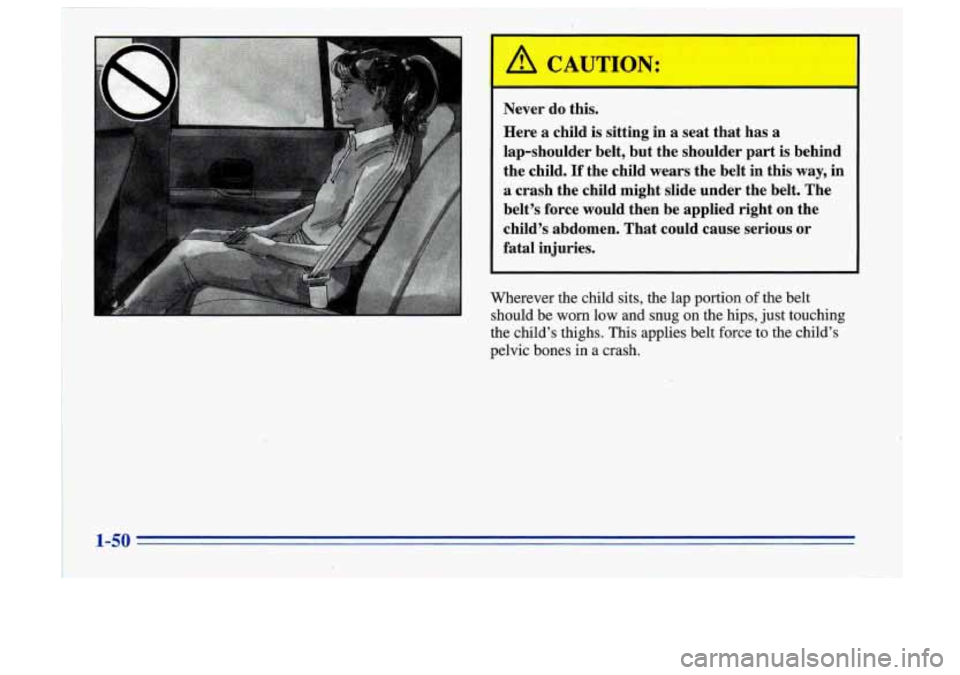
Never do this.
Here
a child is sitting in a seat that has a
lap-shoulder belt, but the shoulder part is behind
the child.
If the child wears the belt in this way, in
a crash the child might slide under the belt. The
belt’s force would then be applied right
on the
child’s abdomen. That could cause serious
or
fatal injuries.
Wherever the child sits, the lap portion of the belt
should be worn low and snug on the hips, just touching
the child’s thighs. This applies belt force to the child’s
pelvic bones in a crash.
1-50
Page 176 of 356

A CAUTION: I
Do not load your vehicle any heavier than the
GVWR, or either the maximum front or rear
GAWR. If you do, parts on your vehicle can
break, or it can change the way your vehicle
handles. These could cause you to lose control.
Also, overloading can shorten the life of
your vehicle.
I NOTICE:
Your warranty does not cover parts or
components that fail because of overloading.
If you put things inside your vehicle -- like suitcases,
tools, packages or anything else
-- they will go as fast as
the vehicle goes. If you have to stop
or turn quickly, or
if there is a ,crash, they'll keep going.
A CAUTION:
Things you put inside your vehicle can strike and
injure people in
a sudden stop or turn, or in
a crash.
0
0
0
0
0
Put things in the trunk of your vehicle. In a
trunk, put them as far forward as you can.
Try to spread the weight evenly.
Never stack heavier things, like suitcases,
inside the vehicle
so that some of them are
above the tops
of the seats.
Don't leave an unsecured child restraint in
your vehicle.
When you carry something inside the
vehicle, secure
it whenever you can.
Don't leave
a seat folded down unless you
need
to.
4-28